Overview
Bearing Witness
South Asia witnessed major political and economic upheaval this past year, even as the region was slowly emerging from the grip of the Covid-19 pandemic. While 23 journalists lost their lives and others were subjected to more than 60 attacks by the police, armed militia, vigilante mobs, politicians, local mafia and others, the broader political events continued to impact the security of journalists and their ability to carry out their professional duties.
From the takeover of Afghanistan by the Taliban in August 2021, to the massive democratic protests against the Sri Lankan government in April 2022 that led the country into its worst economic crisis since independence in 1948, the media in South Asia has borne witness to some watershed moments in history, taking severe beatings but also standing strong to speak truth to power.
Afghanistan endured the grimmest of periods, with the hasty withdrawal of NATO troops in the country after two decades of war, accompanied by the inexorable takeover of the country by the Taliban, province by province, leading up to the eventual capitulation of Kabul on August 15, 2021. While targeted killings of journalists in the country declined, routine harassment, intimidation and even torture of independent media have continued unabated. Unsurprisingly, job losses have been dire. At particular risk are those journalists belonging to minority communities and women, who were swiftly restricted or banned from working. Close to 600 journalists have now reportedly fled the country, hoping to build new lives for themselves and continue to tell the stories of their people.
In December 2021, Bangladesh’s landmark 50 years of independence marking the day that the country’s people achieved liberation, was over-shadowed by the ongoing climate of fear that continues to aggressively curtail freedom of expression nationally.
Across South Asia, the stifling of free speech overall and the harsh consequences for those who speak out was an overwhelming reality across the region. With the large youthful populations of India, Pakistan and other countries in the region taking to the digital space, government and corporate control over the sphere has emerged as a critical and serious concern for media sustainability.
In Nepal, parliamentary and provincial elections scheduled for late 2022 are set to determine the government for the next five years and will also shape the future of the legal and regulatory environment for the media. The current trend of media-related laws constricting free speech in Nepal is leading to an environment of self-censorship and one that is being fiercely challenged by Nepal’s defiant and robust media collective.
The media in South Asia has borne witness to some watershed moments in history, taking severe beatings but also standing strong to speak truth to power.
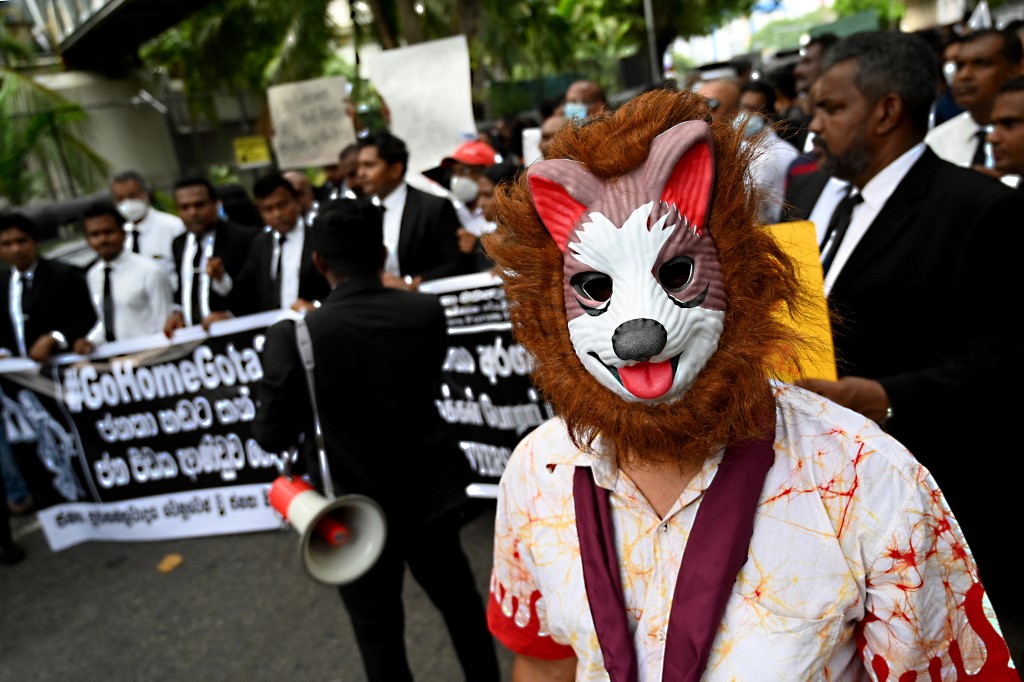
As Sri Lanka grapples with its worst economic crisis in memory, demonstrations in Colombo and across the Island have demanded the government’s resignation. Credit: Ishara S. Kodikara / AFP
Virtual Control
Controlling the online space was a preoccupation of governments across the region.
Bangladesh saw a stupendous ninefold increase in 2021 over the previous year, in cases filed under its stringent Digital Security Act (DSA) for alleged online criticism of officials, including the prime minister and the country’s founder. In the face of criticism of the DSA and its propensity to criminalise free speech – an admission made by Bangladesh’s Law Minister himself – the authorities promised to enact a Data Protection Act. However, the proposed draft contains vague terminology and gives the government arbitrary power to penalise users of the digital space.
Likewise in Sri Lanka, where the parliament in March 2022 passed the Personal Data Protection Bill, concerns have been expressed about the impact of the new law on media reporting and the severe restrictions on the right to information. Critics say the bill could hamper reporting on issues such as corruption, and new provisions on ‘official secrecy’ could restrict the public’s right to information. The provision empowering the concerned minister to appoint any government institution as the Data Protection Authority (DPA), raises concerns about the autonomy of the institution.
In Afghanistan, amidst all the turmoil, journalists and media workers were subjected to severe psychological pressure from the Taliban’s Ministry of the Propagation of Virtue and the Prevention of Vice, with ill-defined provisions that allow arbitrary penalties to be slapped on those deemed to have crossed the line.
In Nepal, bills sitting at the federal and provincial levels and awaiting determination do not bode well for press freedom. The Information Technology Bill, the Nepal Media Council Bill, and the Public Service Broadcasting Bill, are all in the pipeline despite concerns raised by stakeholders about the potential of these proposed laws to criminalise journalism itself.
In early April, in a win for advocates of free speech and in response to a petition filed by the Pakistan Federal Union of Journalists (PFUJ), the Islamabad High Court declared the problematic amendment to the Prevention of Electronic Crimes Act (PECA) null and void.
The collusion between governments and social media conglomerates was exposed in a series of investigative articles by India-based The Reporters Collective and Ad Watch, and published by Al Jazeera in March 2022. The investigation found that the Facebook advertisement platform “systematically undercut political competition” in India, giving the ruling Bharatiya Janata Party (BJP) an “unfair advantage” over other political competitors in the elections. The analysis was based on an examination of 500,000 political advertisements placed on Facebook and Instagram between February 2019 and November 2020 — during which India’s 2019 General Elections and nine State Assembly elections were held. It also analysed how these unfairly promoted the BJP’s campaigns on the platform.
Government propensity to monitor and regulate their citizens was a running theme for the region. India was one of 50 countries where citizens were subjected to surveillance by the spyware Pegasus manufactured by the Israeli group NSO and sold only to governments.
The data analysed by The Wire, part of the international collaboration between French non-profit Forbidden Stories, Amnesty International and 16 media organisations titled “Pegasus Project” and released in July 2021, showed that most were targeted between 2018 and 2019, in the run-up to general elections in India. At least 40 Indian journalists are said to be among 300 others targeted, including a Supreme Court judge.
Allegations by the Opposition in Sri Lanka also raised concerns about the use of Pegasus to spy on journalists in the country. Digital security concerns have now become intrinsically part of overall safety and security concerns for journalists in South Asia.
Misinformation and fake news during the Covid-19 pandemic, which admittedly created public health concerns, was often used as a justification for government control of the media. In Bhutan, the government tightly controlled the media narrative, often in a heavy-handed manner, regulating what and when to report, in the guise of fighting misinformation. On some occasions, the seeming conflict between the right to health and collective rights and press freedom swung in favour of censorship and control.
In Afghanistan, amidst all the turmoil, journalists and media workers have been subjected to severe psychological pressure from the Taliban’s Ministry of the Propagation of Virtue and the Prevention of Vice.
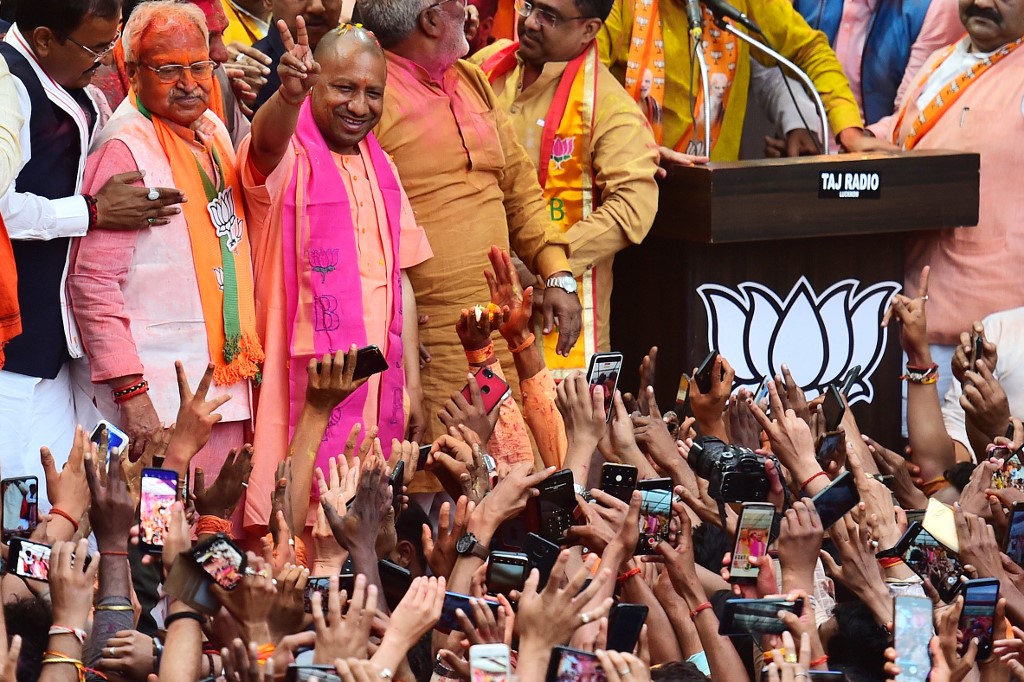
Supporters of India’s Bharatiya Janata Party (BJP) celebrate outside the party office in Lucknow on March 10, 2022, on the day of counting of votes for the Uttar Pradesh state assembly elections. Credit: Sanjay Kanojia / AFP
Dealing with hate speech
What is clear is that the media in South Asia is going through severe trials and tribulations, battling deep economic crises as well as political polarisation, all of which threaten media freedom and media’s very existence.
In recent years, it has become increasingly clear that the online spread of hate and misinformation is a profitable business. When increased attention to certain forms of content results in greater revenue, in accordance with the model of digital capitalism, and algorithms are designed to harvest attention, there is a very real threat of misinformation.
However, in the guise of preventing misinformation, over regulation of content is compromising media freedom. India’s Intermediary Guidelines and Digital Media Ethics Code Rules, 2021, are an example of that overreach. Unfettered powers and misuse by the government were displayed in the blacking out of channels for alleged “security” reasons.
Similar overreach is also feared in Pakistan with the introduction in November 2021 of the Protection of Journalists and Media Professionals Act, with the purported aim of providing a defence mechanism for journalists. The controversial Section 6 prohibits journalists from “spreading false information”, and producing material that “advocates hatred”, or constitutes “incitement to discrimination, hostility or violence”. Such vague definitions have the precise potential for the government to excessively regulate online content.
In the Maldives, new hate speech provisions were added in November 2021 to the penal code to criminalise accusations of apostasy, unless a person explicitly renounces Islam. A section that prohibits “criticism of Islam in a public medium with the intention of causing disregard” was amended to also criminalise publicly insulting or disparaging the Quran, God or Prophet Mohamed. The new provision adds to the 2008 Maldives constitution that outlaws speech that is “contrary to any tenet of Islam”.
The country maintains reservations to the International Covenant on Civil and Political Rights’ Article 18 on freedom of thought, conscience and religion, while the Communications Authority of Maldives regularly blocks websites with anti-Islamic content upon request by ministries and other agencies. Compounded with that, the ongoing fear and threat of attacks by vigilante groups is continuing to encourage self-censorship on digital platforms.
When increased attention to certain forms of content results in greater revenue, in accordance with the model of digital capitalism, and algorithms are designed to harvest attention, there is a very real threat of misinformation.
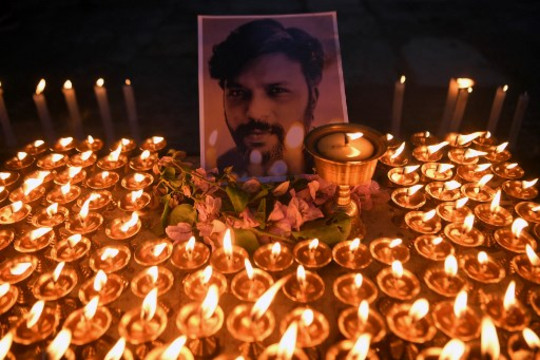
Candles are placed by colleagues next to a portrait of Reuters journalist Danish Siddiqui, who was killed in the crossfire while covering a fierce battle between Afghan security forces and Taliban militants on July 16, 2021. Credit: Prakash Mathema / AFP
Struggle for survival
For the media in South Asia, the year was not only one of maintaining high standards of journalistic content, but also one where the sheer struggle to survive was paramount.
The media in Afghanistan was all but decimated, with more than 300 media outlets shut down, and unable to continue operations due to severe economic unviability and the collapse of much-needed foreign funds after the Taliban claimed control.
Even in relatively peaceful Bhutan, the media has barely managed to survive. Repeated lockdowns during the pandemic brought to the fore the media’s over reliance on government advertising which continued to decline due to the overall sluggish economy. Austerity measures adopted by most media houses included cutting down on staff and field reporting. They were forced to rely on government hand-outs, a move that directly impacted media freedom. Many senior and trained professionals left the industry and many newsrooms dwindled to just an editor and two or three reporters.
The lasting effects of the pandemic were seen in the media industry in India where the economic downturn led to loss of advertising revue. Over-dependence on government advertisements was linked to self-censorship and patterning news content to suit the ruling dispensation. The crisis has seen a shift in the revenue models from advertisement-led to paid content, with more and more legacy media instituting paywalls and subscription-driven models.
The Nepali media too staggered. Under the weight of the economic crisis, journalists’ job security was one of the focus areas of the Federation of Nepali Journalists (FNJ), which negotiated with media houses, staged protests and used the courts to assert labour rights, with some success.
Interestingly, the pandemic years saw the growth of niche digital news outlets producing special focus stories and highlighting issues and regions forgotten by the mainstream media. Clearly, the message for media’s sustainability is that readers need to pay for independent news and reportage that accurately reflects ground realities in all their complexity. The newer digital platforms also appear to be building newsrooms that are diverse and inclusive, representing marginalised sections beyond mere tokensim.
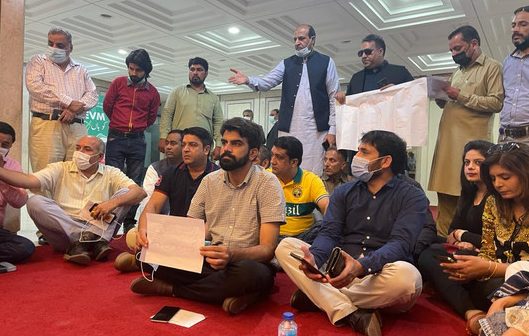
Pakistani journalists participate in a ‘sit in’ demonstration from September 12-13, 2021, in protest against the proposed Pakistan Media Development Authority (PMDA) bill, which aimed to establish a sole authority to regulate all film, electronic, print and digital media. Credit: RIUJ
Away from home
The year 2021 was particularly difficult for journalists in Afghanistan and parts of India such as Jammu and Kashmir. Many reporters were silenced due to pressure from the authorities while to many others were forced to leave their homes and even countries due to security reasons.
The starkest example was that of Afghan journalists, many who were forced to flee their homes and families overnight. The unplanned and sudden exodus saw many journalists living for months in camps in third countries, uncertain about their futures. Some in their new homes, while adjusting to new cultures and languages, are still awaiting work-permits and outlets for their journalistic output. Several Afghan women journalists, who left after being targeted by the Taliban, hope to continue to raise issues for Afghan women.
The repression in Jammu and Kashmir over the past year led several Kashmiri journalists to leave the state. Intimidation, harassment and implication in fake cases has become almost routine, hampering the media from doing its job. The arrest of some of the more vocal journalists sent a chilling message to the media community, which has a tough choice between self-censorship and jail.
The political crisis in Myanmar had a spill over effect in neighbouring India, which has long been home to exiled Burmese journalists. In April 2021, three journalists who worked with Mizzima, a multimedia news organisation who had taken refuge in the bordering Indian state of Manipur were in danger of being sent back to Myanmar where they would face a jail term or worse. In a show of solidarity, the All Manipur Working Journalists’ Union (AMWJU) took up advocacy on behalf of the journalists to allow them to remain. An Indian court later granted them sanctuary.
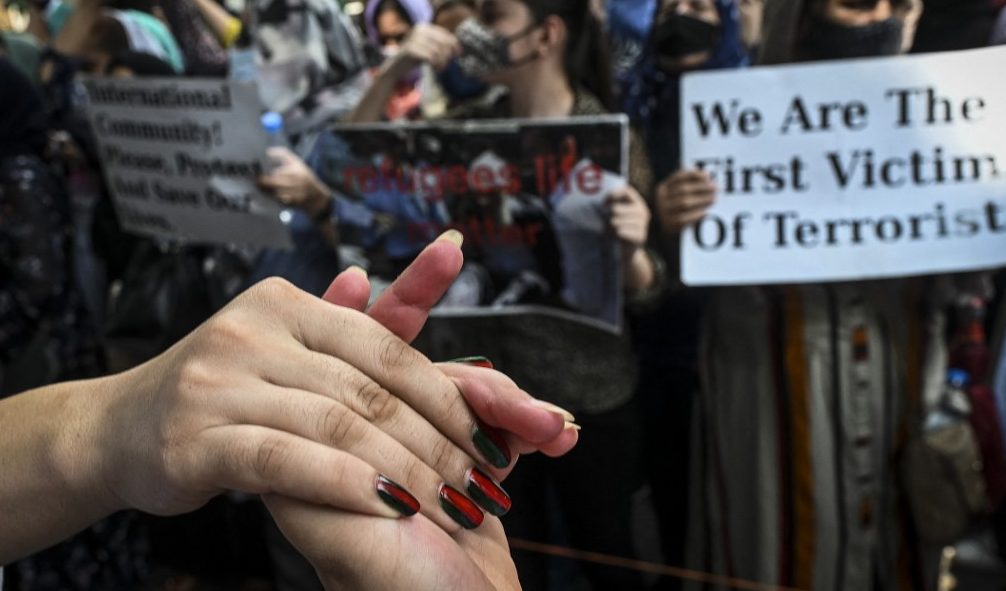
Afghans residing in India protest the Taliban’s military takeover of Afghanistan outside the UN Refugee Agency (UNHCR) office in New Delhi on August 23, 2021. Across South Asia, displays of international solidarity marked a collective denigration of Afghanistan’s new regime. Credit: Sajjad HUSSAIN / AFP
Hope from the judiciary
With governments in the region trampling upon citizens’ rights, the judiciary in many countries stepped in to uphold constitutionally guaranteed rights to freedom of speech and expression and freedom of the press.
In landmark cases dealing with defamation and sedition, the Supreme Court of India unwaveringly upheld citizens’ right to critique the government. In petitions challenging the government’s illegal surveillance, in the wake of the Pegasus investigation in July 2021, the Chief Justice of the Supreme Court of India, NV Ramana said, “allegations are serious if the reports are correct…The truth has to come out”.
In Pakistan, the Islamabad High Court (IHC) in a landmark ruling in April 2022, struck down criminal defamation in the Pakistan Electronic Crimes Act, a decisive order in favour of press freedom. The IHC by converting letters by the PFUJ regarding illegal terminations, irregular salaries and safety issues into petitions, is another positive move towards journalists’ rights.
In some cases, lower courts pushing for rule of law also came as a welcome step. A local court directed the Federal Investigation Agency (FIA) of Pakistan to ensure filing of investigation reports in court regarding 1,200 pending inquiries relating to online harassment, identity theft, pornography and other offences registered in Karachi.
In the Maldives, on January 19, 2022, a criminal court found two men guilty of murdering blogger Yameen Rasheed in 2017 and sentenced them to life imprisonment. The police said that the group of radicalised young men believed that Yameen deserved to be killed for “insulting Islam”. Although the trial was bumpy, witnesses were intimidated and the authorities’ professionalism was called into question, that an indictment of the perpetrators was reached is a step forward.
Likewise, the April 13, 2022, verdict of a Dhaka court sentencing to death four of those accused of murdering eminent secular writer Professor Humayun Azad in 2004 provides a hope that the wheels of justice are turning, albeit very slowly.
In landmark cases dealing with defamation and sedition, the Supreme Court of India unwaveringly upheld citizens’ right to critique the government.
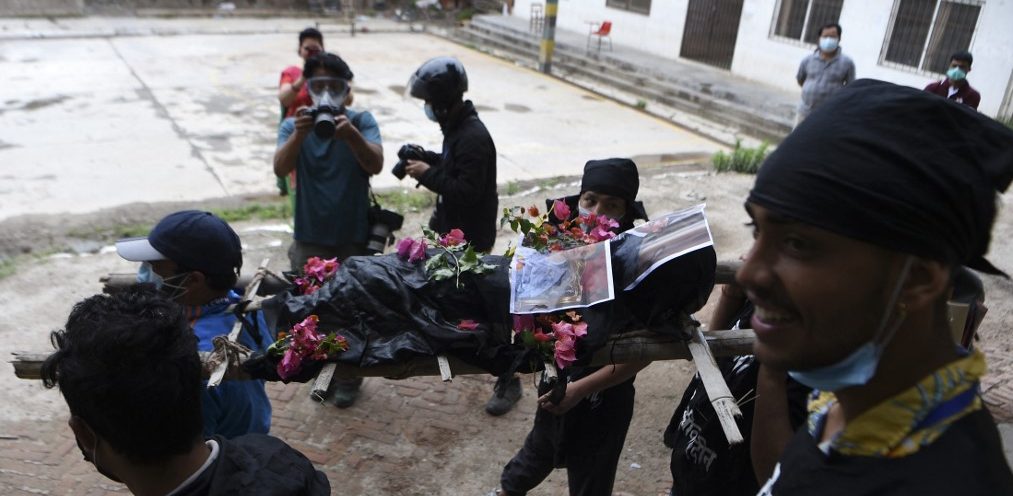
Members of the Nepalese Students Union carry an effigy of President Bidhya Devi Bhandri and Prime Minister Sharma Oli on May 25, 2021, after Nepal’s parliament was dissolved for the second time in just five months. Credit: Prakash Mathema / AFP
UN Special Rapporteurs speak
Even as the situation for journalists declined in many countries, United Nations Special Rapporteurs stepped in to express concern. Highlighting the harassment of journalists in Jammu and Kashmir, the UN Special Rapporteur on promotion and protection of the right to freedom of opinion and expression, Irene Khan, and Elina Steinert, the vice-chair of the Working Group on Arbitrary Detention in June 3, 2021, urged, “all necessary interim measures be taken to halt the alleged violations and prevent their re-occurrence and in the event that the investigations support or suggest the allegations to be correct, to ensure the accountability of any person(s) responsible for the alleged violations,” The report cited examples of jailed journalists and the use of the Unlawful Activities Prevention Act and other counter-terror laws on journalists.
In March 2022, UN human rights experts including from the UN Working Group on Enforced or Involuntary Disappearances, Special Rapporteur on extrajudicial, summary or arbitrary executions; Special Rapporteur on the situation of human rights defenders and the Special Rapporteur on the right to freedom of opinion and expression called upon Bangladesh to “immediately cease reprisals against human rights defenders and relatives of forcibly disappeared persons for their activism and co-operation with international human rights bodies and UN mechanisms.” This statement was issued following the threats and intimidation of civil society and human rights defender after the announcement of sanctions imposed by the United States of America against top Rapid Action Battalion (RAB) officials on December 10, 2021.
Right to information
Access to information has always been a thorny issue in the region, with most governments refusing to be transparent or accountable. The arrest of Bangladeshi journalist Rozina Islam in April 2021 under the Official Secrets Actis was a stark example of how a journalist seeking to investigate suspected corruption into the country’s health ministry was not only denied access to information but was also penalised for it.
Even in the Maldives, where its Right to Information Act ranks 16th out of 128 RTI laws in the world, things are not smooth: the country’s third Information Commissioner took up his post in September 2021, nearly seven months after the former commissioner resigned.
In Pakistan, a February 2022, amendment to the cybercrimes law, PECA also threatened the right to information. But a progressive ruling by the Islamabad High Court declared the entire ordinance unconstitutional, thus protecting the Right to Information guaranteed by the Constitution of Pakistan.
Even as the situation for journalists declined in many countries, United Nations Special Rapporteurs stepped in to express concern.
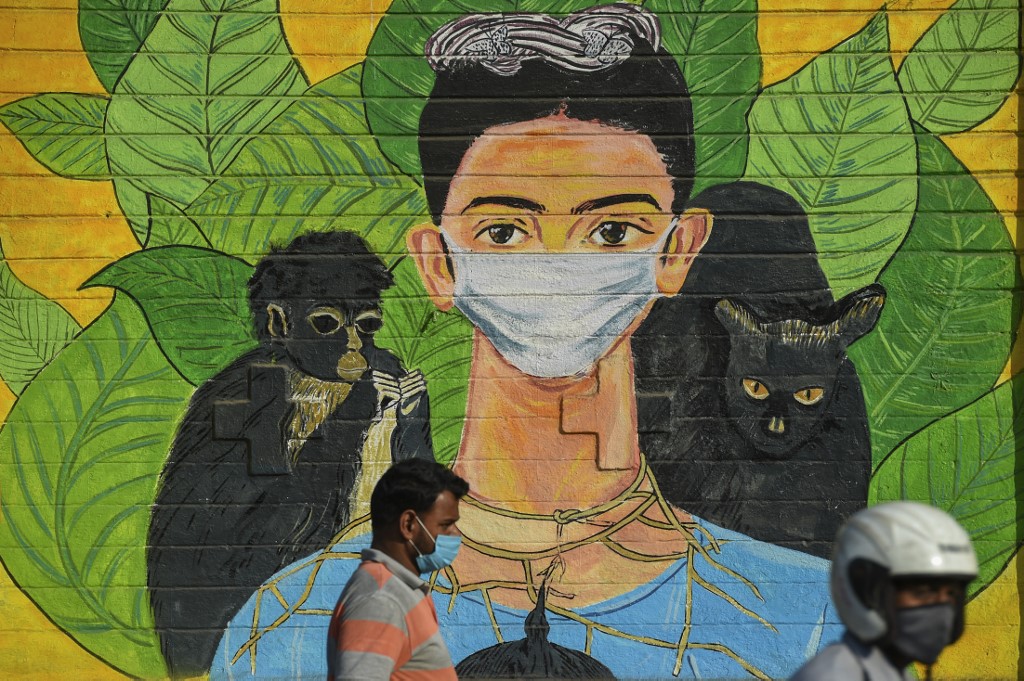
India’s intense struggle with Covid-19 is evident as pedestrians pass a mural depicting Mexican painter Frida Kahlo wearing a facemask in Mumbai on January 29, 2022. Credit: Punit Paranjpe / AFP
Gender inequity
The sharp decline in gender equity was nowhere starker than in Afghanistan, where women journalists were denied their right to work and be active in the public sphere. The forced retreat has undone two decades of work in enhancing gender equity in the Afghan media.
The November 2021 regulation issued by the Taliban government with 11 ‘rules’, urging the media to refrain from broadcasting TV programs and dramas which featured women meant that women have almost disappeared from public view, except in roles and attire approved by the Taliban. Women journalists, like all professional Afghan women, were prohibited from driving alone, their mobility tied to the presence of a male family member.
Meanwhile outspoken women journalists in Pakistan faced intense online harassment, including being trolled by even senior government officials who joined the online intimidation and bullying.
In India, the battle to push women out of the online space was unrelenting. Vicious online abuse, trolling, death and rape threats were particularly severe for Dalit and Muslim women who were regularly silenced and abused. In July 2021, an online ‘auction’ of prominent Muslim women, including journalists called ‘Sulli deals’ and once more in early 2022 called ‘Bulli Bai’ (‘Sulli’ and ‘Bulli’ are derogatory slang for Muslim women) was launched. The Internet Freedom Foundation called the fake online auction of almost 100 Muslim women a “blatant violation of their data security and privacy rights.” These online apps on the GitHub platform, profiling Muslim women activists, journalists, analysts, artists and researchers were taken down after vigorous protests.
The good news is that for every violation of women journalists’ rights, there has been an equally strong resistance.
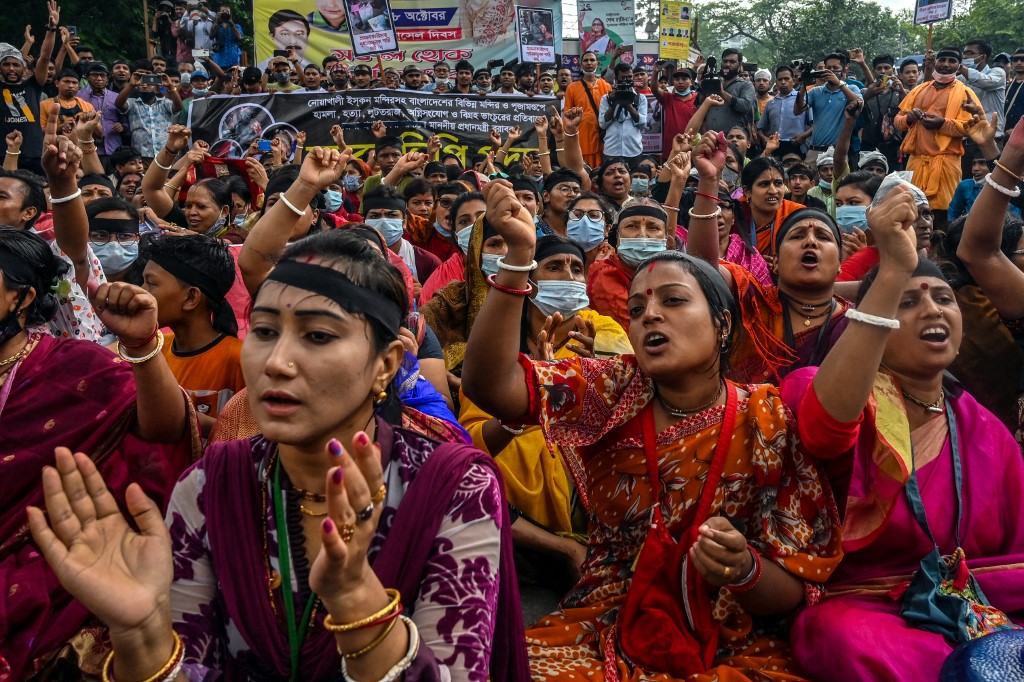
Bangladeshi Hindus stage a demonstration in Dhaka on October 18, 2021 to protest against the fresh religious violence against Hindus in the country. Credit: Munir Uz Zaman / AFP
Way forward
The bleak post-pandemic year has held many lessons for the media in the region. The first is that of sustainability and survival, and the need to diversify and remain relevant. Simultaneously it is also about lobbying for journalists’ rights – on the streets, in boardrooms and in courts.
The other is the importance of solidarity and leveraging networks to support media colleagues both within and across borders. The need to speak out and act has never been as important at a time when hyper nationalism is making states fold in unto themselves. In the case of Afghan journalists, for example, there is a need for intervention on several fronts – from financial assistance to capacity building and supporting those in exile. The international media community must continue to train the spotlight on the crisis of the media in Afghanistan and extend long term support and solidarity.
The focus must also remain on Sri Lanka, where the economic crisis is likely to be long drawn out, and media freedoms likely to be compromised as the state attempts to repair the damage. International solidarity at such a time is crucial.
